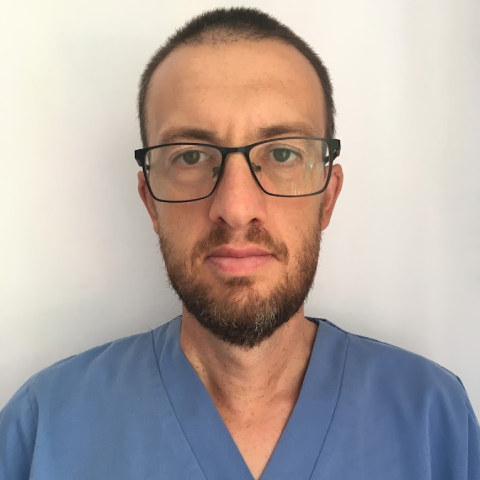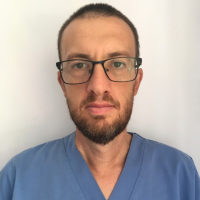Quantitative Sensory Testing for busy osteopaths: a powerful and easy evaluation tool
Introduction
Chronic pain is defined as pain that lasts longer than three months2 or that lasts longer than the projected healing period3. Chronic pain causes neuroplastic changes in the nervous system (peripheral or central), which are important not only for classifying the pain mechanism (nociceptive, neuropathic, nociplastic), but also for a better treatment management plan, including osteopathic treatment4-8.
These mechanisms can be assessed through quantitative sensory tests (QST)9 namely pressure pain threshold (PPT), temporal summation of pain (TSP), and conditioned pain modulation (CPM). PPT assessed in a painful and non-painful area, can differentiate in a quantifiable way localized muscle hyperalgesia (peripheral sensitisation) from widespread hyperalgesia (central sensitisation)8,10. TSP assesses the wind-up process reflecting dorsal horn excitability7,11, and CPM tests the inhibitory pain mechanism7,12.
Furthermore, nociplastic pain does not exclude nociceptive pain from being important in determining whether there is a peripheral, central, or both pain mechanisms to determine whether the treatment method will be top-down, bottom-up, or a combination of both.13 Also, other sensory perception changes must be assessed and included into therapy programs. One of these changes is altered back self-perception and tactile acuity in chronic low back pain14-17.
Recognising nociplastic pain remains difficult in clinical practice. In cases of chronic pain, assessing pain mechanisms is an important step in the decision-making process toward individual care rather than a diagnosis5,8. QST can currently assess and identify pain mechanisms using reference values, cut-off points, and clinical bedside instruments that are easily transferable to clinical practice. This course is arranged into an online theoretical component and two “in-person” days with a thorough practical component where participants will develop skills in administering QST in clinical practice in various chronic musculoskeletal disorders.
Course Content
- Revision of Neurophysiology of Pain Fundamental Concepts
- Pain Classification
- Quantitative Sensory Testing: Pressure Pain Threshold, Temporal Summation of Pain, Conditioned Pain Modulation, Exercise Induced Hypoalgesia, and Two-point Discrimination: Evidence and Theory
- Assessing Nociceptive Processing – Allodynia, hyperalgesia
- Pressure Pain Threshold
- Temporal Summation of Pain
- Pinprick and movement
- Conditioned pain modulation
- Exercise Induced Hypoalgesia
- Two points discrimination
– Theory and practice - Neuropathic pain
– Theory and practice
– Fibromyalgia - Clinical cases discussion
– Chronic low back pain; chronic neck pain; chronic hip/knee pain; chronic headache and temporomandibular joint pain.
Course aims
- Increase knowledge of pain neurophysiology and use contemporary principles in the assessment and management of chronic pain patients.
- Recognise the utility and promise of QST in clinical practice for assessing and differentiating pain mechanisms.
- Clinical case discussion to include the clinical decision-making process into the treatment management plan based on QST findings.
Learning objectives
At the end of this course, participants will:
- Apply the research that underpins quantitative sensory testing in the assessment and treatment.
- Learn how to perform quantitative sensory testing in clinical settings for various chronic musculoskeletal disorders.
- Recognise nociplastic pain presentations and probable plastic areas within the central nervous system for a more effective treatment plan.
- Recognise and comprehend risk variables that contribute to pain sensitisation and incorporate them into patient management.
Research supporting the course
- Nunes A, Arendt-Nielsen L, Espanha M, Teles J, Moita J, Petersen KK. Bedside clinical tests to assess sensitization in office workers with chronic neck pain. Somatosensory Motor. Research. 2021, ;38(4):357–65. http://www.ncbi.nlm.nih.gov/pubmed/34635001
- Smith, B., Fors, E., Korwisi, B., Barke, A., Cameron, P., Colvin, L., Richardson, C., Rief, W., & Treede, R-D. (2019). The IASP classification of chronic pain for ICD-11: applicability in primary care. Pain, 160, 83-87. http://dx.doi.org/10.1097/j.pain.0000000000001360
- Paolucci, T., Attanasi, C., Cecchini, W., Marazzi, A., Capobianco, S. V, & Santilli, V. (2019). Chronic low back pain and postural rehabilitation exercise: a literature review.Journal of Pain Research, 12, 95–107. https://doi.org/10.2147/JPR.S171729
- Boudreau, S., Farina, D., & Falla, D. (2010). The role of motor learning and neuroplasticity in designing rehabilitation approaches for musculoskeletal pain disorders. Manual Therapy,15, 410-414. http://doi.org/10.1016/j.math.2010.05.008
- Chimenti, R. L., Frey-Law, L. A., & Sluka, K. A. (2018). A mechanism-based approach to physical therapist management to pain. Physical Therapy, 95, 302-314. http://doi.org/10.1093/ptj/pzy030
- Pavlakovic, G., & Petzke, F. (2010). The role of quantitative sensory testing in the evaluation of musculoskeletal pain conditions. Current Rheumatology Reports, 12, 455-461. http://doi.org/10.1007/s11926-010-0131-0
- Pelletier, R., Higgins, J., & Bourbonnais, D. (2015). Is neuroplasticity in the central nervous system the missing link to our understanding of chronic musculoskeletal disorders? BMC Musculoskeletal Disorders, 16:25. http://doi.org/10.1186/s12891-015-0480-y
- Arendt-Nielsen, L., Morlion, B., Perrot, S., Dahan, A., Dickenson, A., Kress, H. G., Wells, C., Bouhassira, D., & Drewes, A. M. (2018). Assessment and manifestation of central sensitisation across different chronic pain conditions. European Journal of Pain, 22, 216–241. http://doi.org/10.1002/ejp.1140
- Kosek, E., Cohen, M., Baron, R., Gebhart, G F., Mico, J-A., Rice, A. S. C., Rief, W., & Sluka, A. K. (2016). Do we need a third mechanistic descriptor for chronic pain states. Pain,157, 1382-1386. http://doi.org/10.1097/j.pain.0000000000000507
- Arendt-Nielsen, L., Fernández-de-las-Peñas, C., & Graven-Nielsen, T. (2011). Basic aspects of musculoskeletal pain: from acute to chronic pain. The Journal of Manual & Manipulative Therapy, 19(4), 186–193. http://doi.org/10.1179/106698111X13129729551903
- Latremoliere, A., & Woolf, C. (2009). Central sensitization: a generator of pain hypersensitivity by central neural plasticity. The Journal of Pain, 10, 895-926. http://doi.org/10.1016/j.jpain.2009.06.012
- Heinricher, M., Tavares, I., Leith, J., & Lumb, B. (2009). Descending control of nociception: specificity, recruitment and plasticity. Brain Research Reviews, 60, 214-225. http://doi.org/10.1016/j.brainresrev.2008.12.009
- Fryer, G., (2017). Integrating osteopathic approaches based on biopsychosocial therapeutic mechanisms. Part 2: Clinical Approach. International Journal of Osteopathic Medicine, 26, 3643.
- Moseley, G. L., (2008). I can’t find it! Distorted body image and tactile dysfunction in patients with chronic back pain. Pain, 140(1), 167–171
- Luomajoki, H., & Moseley, G. L. (2011). Tactile acuity and lumbopelvic motor control in patients with back pain and healthy controls. British Journal of Sports Medicine, 45(5), 37–440. https://doi.org/10.1136/bjsm.2009.060731
- Senkowski, D., Heinz, A., (2016) Chronic pain and distorted body image: Implications for multisensory feedback interventions. Neuroscience and Biobehavioral Reviews, 69:232- 239
- Catley, M. J., O’Connell, N. E., Berryman, C., Ayhan, F. F., & Moseley, G. L. (2014). Is tactile acuity altered in people with chronic pain? a systematic review and metaanalysis. The Journal of Pain, 15(10), 985–1000. https://doi.org/10.1016/j.jpain.2014.06.009
My name is Alexandre Nunes, and I have over 20 years of clinic experience as an osteopath. Currently, I am the coordinator and programme leader of the Bachelor of Science degree in Osteopathy at Instituto Piaget in Portugal, and a lecturer at the School of Healthcare at Atlântica University also in Portugal. I earned my PhD in Rehabilitation from the University of Lisbon’s Faculty of Human Kinetics. The thesis was titled “Nociplastic pain in office workers with chronic neck pain” and included quantitative sensory tests. During an internship at Aalborg University’s SMI -Department of Health Science and Technology, under the guidance of Prof. Kristian Petersen, I learned how to execute these procedures. One of our published publications used basic bedside clinical measures to determine sensitisation in individual office employees with chronic neck pain.1
Alexandre Nunes

Osteopaths who treat patients suffering from chronic pain
Certificate of continuous professional development (CPD) issued by Medi-Cine Online Learning Academy
English, Portuguese
30
20 h ( 16 h in person, 4 h online)
2 days - 1 Module



